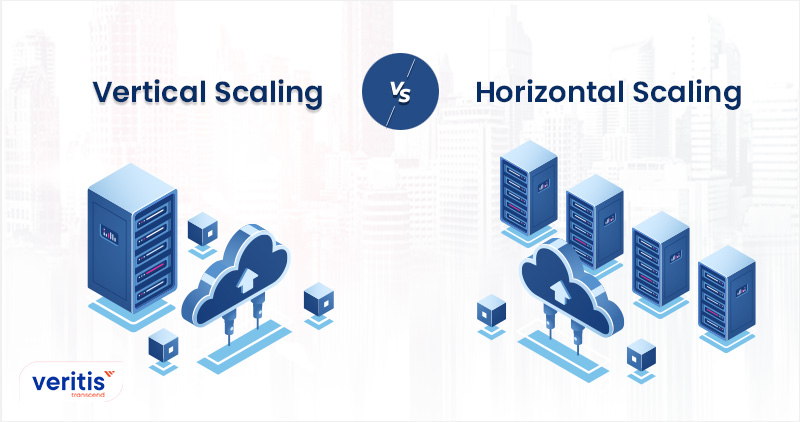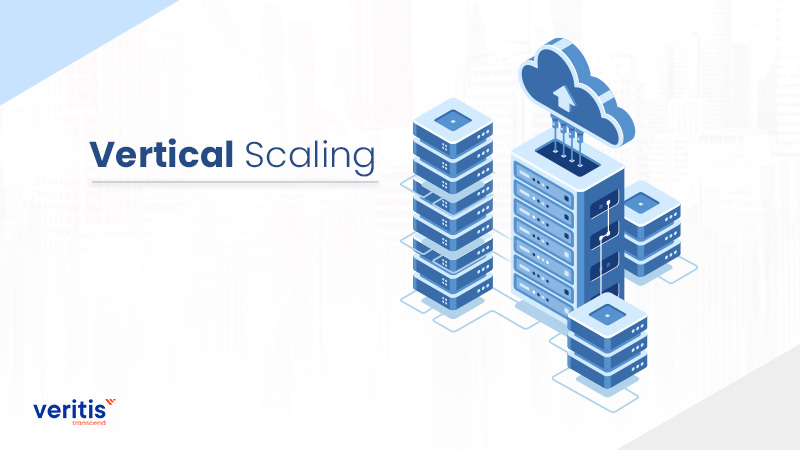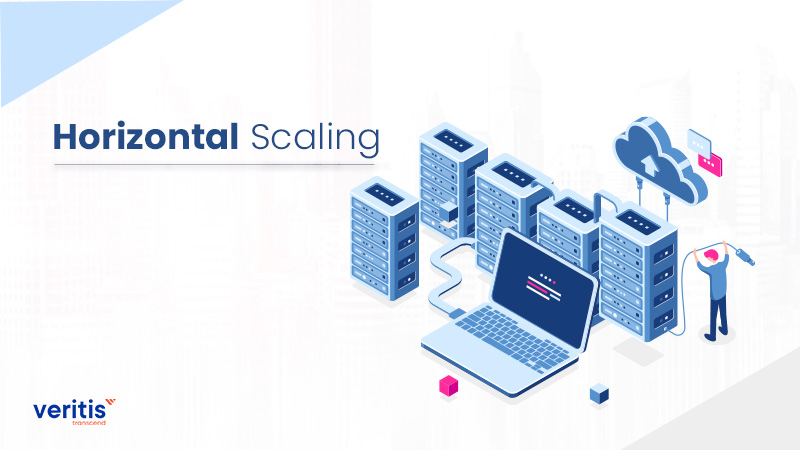Vertical Scaling Vs. Horizontal Scaling: Which One Should You Opt For?

Change is one of the critical aspects that decide an enterprise’s future. While change fosters growth, enterprises either have to expend many resources or shed some non-essential systems. In traditional business houses, coping with change is a big deal as one would have to make the changes quickly, which is not something that everyone can perform deftly.
To boil it down, the organizations would have to add or shed some of their servers to handle the change in demand. While this is a complex task for the traditional legacy business houses, enterprises that have integrated with cloud technology experience seamless scaling technologies.
But why is this scalability so strongly associated with cloud computing? Regardless of whichever sector you are in when dealing with cloud computing scalability, it is one of the aspects you keep encountering. And while scalability makes the cloud outclass the traditional setups, certain intricacies are involved.
The primary distinction between horizontal and vertical scaling lies in their approaches to handling increased demands in a system. Horizontal scaling entails increasing the number of machines or nodes to supply the workload, while vertical scaling involves enhancing existing machines’ power (CPU, RAM, storage, etc.). Essentially, horizontal scaling expands by adding more units, while vertical scaling amplifies by upgrading existing units. Horizontal scaling is commonly employed to manage growing traffic or workloads, while vertical scaling is preferred for resource-intensive tasks or applications requiring more processing capabilities.
As businesses expand and their customer base grows, numerous aspects, such as workforce size and resource requirements, change. Correspondingly, cloud infrastructure also evolves to meet these new demands. Consequently, there’s a need for increased cloud computing power to accommodate additional customers and maintain expanded databases. However, choosing between horizontal and vertical scaling can require careful consideration of their advantages and disadvantages, as they each offer unique benefits and challenges for businesses adapting to growth.
This blog will explore scalability, what these vertical and horizontal scalabilities are, and which one should go with.
Scalability
Whenever there is a peak stage, one needs more resources to capitalize on the time. Once the demand peaks, the user is left with unwanted resources, which metaphorically collect dust. In day-to-day life, it is like having an unmown lawn. To maintain it, you get a lawnmower and restore the lawn to its beauty. But once the job is done, you must tuck away the lawnmower until the next mowing session.
Instead, you don’t have the lawnmower in the cloud and don’t wish to have it around unless you need it. You can borrow tools from your neighbors to do the job. Once the job’s done, you can return it, and with that approach, you don’t have to own a resource you only need during certain times.
The same applies to the cloud; you need to rope in extra resources when needed and pay up only for what you use. These resources can range from extra storage to additional RAM power. Effectively, cloud computing scalability takes on resources when required and during lean periods, shedding unwanted resources to save monetary resources.
What makes cloud scalability lucrative for businesses is instant availability. While there are predictive spikes, there is always a sudden surprise spike in traffic, and it demands stunted latency without downtimes. Thankfully, cloud providers make the required resources available within no time.
Now that scalability has been delved into, let’s look at vertical and horizontal scaling.
Useful Link: Amazon Redshift Vs Azure Synapse Analytics: Difference Between Top Data Warehouses
Vertical Scaling

Vertical scaling refers to the up-scaling process where your infrastructure’s computational capacity is boosted to mitigate the new requirements. This process, called scale-up, allows you to retain the resources in the existing logical unit. As a result, the infrastructure’s network capacity, storage power, and processing ability will be expanded.
Horizontal Scaling

In horizontal scaling, computational power and devices are involved. Here, you add more devices and distribute the existing computational capacity over the existing and additional devices. So, while computational power won’t spike, the devices across your infrastructure would increase. This distribution is what separates horizontal scaling from vertical scaling. It is different types of scaling out.
Useful Link: ITOps vs DevOps vs NoOps Comparison
Vertical Scaling vs. Horizontal Scaling
Although scalability is mainly associated with computational power, hardware is the key aspect that sets horizontal scaling apart from vertical scaling. Vertical scaling enhances the hardware configuration without disturbing or modifying the logical unit. In horizontal scaling, the hardware specifications remain the same while the number of instances spikes. In other words, the hardware infrastructure is increased by adding more devices with the exact specifications.
The other aspect they differ upon is that a sequential piece of logic is broken into smaller units and implemented on multiple devices in horizontal scaling. The breakup of the code allows programmers to execute multiple tasks parallelly over different devices. Vertical scaling is not the case, as the logic code remains unchanged. The unchanged code is run across the boosted infrastructure. With the differences out of the way, let’s look at the advantages of both scaling methods.
Pros and cons of Vertical Scaling and Horizontal Scaling
As with everything, both scaling methods have advantages and disadvantages. Both approaches differ, particularly in code and hardware. Vertical scaling does not involve a code change and is much easier to execute than horizontal scaling. The operations are easier to manage, and the data centers on one node.
This centralized node allows you to run the operations across multiple devices. In addition, the expenses are reduced in vertical scaling as your infrastructure footprint isn’t increased. This boils down to the company not dedicating extra monetary resources to power consumption and cooling units. Additionally, managing the network from the nodal device is more straightforward and better from the control point.
The disadvantage of vertical scaling is that your hardware can only expand up to a specific limit. Though one can always boost the hardware on certain aspects, the scope to expand it holistically narrows down significantly. Also, one would have to shut down the required devices whenever they are scaling up, resulting in downtime. Additionally, the nodal device has to be taken care of, as unexpected downtimes from that device would stunt productivity.
Horizontal scaling scores well in these aspects as one adds additional devices to consume the existing power. No downtime is involved; you can choose how many devices you choose. The nodal control mechanism doesn’t exist in this scaling approach, which betters resilience. However, it runs aground on the data aspect. The data must be partitioned into multiple units due to multiple devices. This partition also complicates data sharing and processing.
Differences Between Vertical Scaling Vs. Horizontal Scaling
The primary difference between horizontal and vertical scaling is handling increased system demands. Horizontal scaling, or scaling out, implies adding more machines or nodes to supply the workload across numerous devices. In contrast, vertical scaling, also known as scaling up, involves enhancing the power and capacity of existing machines by upgrading hardware components such as CPU, RAM, and storage.
| Parameters | Vertical Scaling | Horizontal Scaling |
| Description | Description Adjusting the system’s power to manage fluctuations in workload, either by increasing or decreasing it as needed. Adjusting the cluster or system’s node count to accommodate changes in workload, either by increasing or decreasing the number of nodes as required | Adjusting the cluster or system’s node count to accommodate changes in workload, either by increasing or decreasing the number of nodes as required |
| Implementation | Requires minimal time, expertise, and effort | It involves a more significant investment of time, expertise, and effort |
| Workload Distribution | A single node manages the entire workload | The workload is divided among multiple nodes. Different nodes host various parts of the workload |
| Configuration | The code can run on a higher-spec device without any modifications. | To enable concurrent execution of workloads on multiple machines, sequential logic needs to be modified |
| Complexity and Maintenance | Decrease | Increase |
| Required Architecture | Every | Scattered |
| Concurrency | It depends on concurrent processing within the current machine to manage simultaneous requests | It spreads numerous tasks across multiple machines connected via the network simultaneously. This helps in decreasing the workload on individual machines |
| Networking | Reduced speed of communication between machines | Fast communication between machines |
| Load Balancing | Unnecessary on the single-node | It is essential to distribute the workload effectively across multiple nodes |
| Costs | Initially inexpensive, it becomes less cost-effective over time | Initially expensive but cost-effective in the long run |

Deciding Factors
With both approaches scoring better than the other, a few crucial aspects help you decide which one to take.
Costs Involved
Vertical scaling requires you to spend at the onset of the adoption itself. You will pay for the higher power, and effectively, it fares well in the initial stages. In horizontal scaling, you wouldn’t have to pay up much at the onset of the scaling process. You would be required to pay for the devices when you opt for them, but later on, your cost overheads would crop up in the form of cooling systems and space requirements.
Clientele
Horizontal versus vertical scaling allows you to circumvent latencies and outages. You don’t have to shut down the servers to implement the scaling process. However, adopting a vertical scaling process would be better if the localized customer base and the burgeoning requirements demand higher processing power. As the latencies and outages are involved, your clientele should be okay with such aspects
Performance
Vertical scaling reduces your flexibility to a certain extent, as today’s technology limits you. In this approach, you wouldn’t be free to choose whatever you wish. In horizontal scaling, you can choose the required configuration and optimize operational costs.
Useful Link: AWS Vs Azure Vs GCP
Download PDF
Trouble Deciding?
While the choice seems easy, scaling is decided by your infrastructure’s architecture and other factors. Also, you should realize that vertical and horizontal scaling is not a choice one should always make. One can implement both the scaling processes and reap its benefits.
While it sounds easy, improper scaling would stunt your production process and demand higher monetary resources. To avoid this, Fortune 500 and emerging companies have hired Veritis, the Stevie and Globee Business Awards winner, to enhance their production processes.
So, reach out to us and scale your infrastructure as best as possible.
Explore IT Infrastructure Services Got Questions? Schedule Now
Additional Resources:
- EKS Vs. AKS Vs. GKE: Which is the right Kubernetes platform for you?
- A Guide to DevOps Implementation on Google Cloud
- Serverless Vs Containers: Comparison Between Top Two Cloud Services
- AWS vs Azure vs GCP: Cloud Cost Comparison
- Top 10 DevOps Tools to Pick for Your Business
Vertical Scaling Vs Horizontal Scaling – Faq’s
Both have their benefits. Vertical scaling provides you higher processing power, data servers, and additional resources.
Horizontal scaling gives you ability to distribute your existing power better by adding more devices to the infrastructure.
At the onset of the vertical scaling, you would have to expend monetary resources to get started and the overheads come down relatively.
In horizontal scaling, your overheads increase after you start as you would have to spend on cooling systems and make space for the increasing devices.
Horizontal scaling allows you make use of the existing computational power. Additionally, you get to add devices of your choice.
Additionally, you don’t have to cough up a great deal of money at the onset of horizontal scaling as you need to spend the money only on the devices procurement.
Vertical scaling is used by companies which afford minor downtimes and by those who need high processing power with expansive storage.
The downtimes come into the picture as companies may need to rejig their hardware to match new processing abilities.